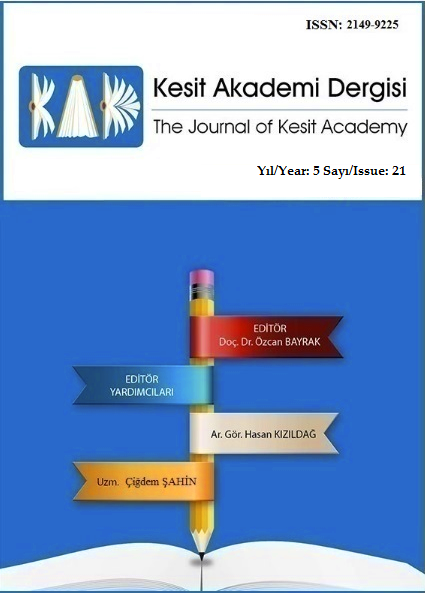Author :
Abstract
Edebiyat tarihimizde takriben altı asırlık bir döneme hâkim olan klâsik Türk edebiyatının temelinde İslamî kültürün yeri büyüktür. Bu bağlamda İslâmî literatür çerçevesinde ortaya çıkan birçok farklı edebî türün klâsik edebiyat şairlerinin ilgisini çektiği, eserlerinde onlara ayrı bir kıymet verdikleri görülmektedir. Söz konusu edebî türlerden birisi de na’ttır. Hz. Peygamber’e karşı hissetikleri muhabbetin bir göstergesi olarak pek çok şairin coşkuyla kaleme aldığı na’t, edebiyatta en çok sevilen ve rağbet gören türlerdendir. Klâsik edebiyatımızda divanlarda ve mesnevilerde na’t yazmak bir gelenektir. Şairler, başta Kur’ân-ı Kerîm olmak üzere hadis-i şeriflerden ve tasavvuf kültürü çerçevesinde teşekkül eden Hz. Peygamber anlayışından yola çıkarak yüzlerce na’t yazmışlardır. Çalışmamızda, klâsik edebiyatta en fazla na’t yazan şairlerden birisi olmasıyla bilinen Yahyâ Nazîm’in Dîvân’ında yer alan na’tlardaki Hz. Peygamber tavsifleri incelenecek, şairin muhayyilesindeki Hz. Peygamber tasavvuru ortaya konmaya çalışılacaktır.
Keywords
Abstract
Islamic culture has an important place on the basis of classical Turkish literature which has been dominant in our literary history for nearly six centuries. In this context; It is seen that many different literary genres emerged within the framework of Islamic literature attracted the attention of classical literary poets and gave them a distinct value in their works. One of the literary genres in question is na’t. Many poets wrote poetry as an enthusiastic indicator of their feelings towards Prophet Muhammad. Therefore, na’t has been one of the most popular and popular genres in literature. It is a tradition in our classical literature to write na’t in divans and mesnevi. The poets have written hundreds of na’t based on the hadith, the Quran, and the idea of the Prophet Muhammad, who was formed within the framework of sufi culture. In this study, the descriptions of the Prophet Muhammad in Yahya Nazim’s Divan, which is known to be one of the most famous writers in the literature, will be examined and the imagination of the Prophet Muhammad in the imagination of the poet will be tried to be revealed.
Keywords
- Çağlıişlek, Aynur (1991). Yahyâ Nazîm Divanı II (İnceleme-Metin). Yayımlanmamış Yüksek Lisans Tezi,
- Çağlıişlek, Aynur (1991). Yahyâ Nazîm Divanı II (İnceleme-Metin). Yayımlanmamış Yüksek Lisans Tezi, Erciyes Üniversitesi, Sosyal Bilimler Enstitüsü, Kayseri.
- Devellioğlu, Ferit (1997). Osmanlıca-Türkçe Ansiklopedik Lugat. Ankara: Aydın Kitabevi. Doğan, Mehmed (1996). Büyük Türkçe Sözlük. İstanbul: İz Yayıncılık.
- Gümüş, Nevin (1992). Yahyâ Nazîm Divanı I (İnceleme-Metin). Yayımlanmamış Yüksek Lisans Tezi,Kayhan Ertürk, Şaziye (1996). Yahya Nazim Divanı V (İnceleme-Metin). Yayımlanmamış Yüksek Lisans Tezi, Erciyes Üniversitesi, Sosyal Bilimler Enstitüsü, Kayseri.
- Kurban, Ahmet (1992). Yahya Nazim Divanı IV (İnceleme-Metin). Erciyes Üniversitesi, Yayımlanmamış Yüksek Lisans Tezi, Sosyal Bilimler Enstitüsü, Kayseri.
- Kuşeyrî, Abdülkerim(2005). Kuşeyrî Risalesi. İstanbul: Yasin Yayınevi.
- Kuzubaş, Muhammet (2003). Divan Şiirine Kaynaklık Etmesi Bakımından Kur’ân. Diyanet İlmî Dergi, Yaz Sayısı, 101-116
- Şimşek, Mehmet (2007). Yahya Nazim Divanı III (İnceleme-Metin). Yayımlanmamış Yüksek Lisans Tezi,Uzun, Mustafa; Özcan, Nuri (2006). Nazîm. TDV İslâm Ansiklopedisi, C. 32, İstanbul: TDV Yayınları, 452-453. https://islamansiklopedisi.org.tr/nazim--divan-sairi, Erişim Tarihi: 09.09.2019
- Uzun, Şerife Uzun (2014). Na’t Geleneğinde Şeyh Gâlib Örneği. Turkish Studies, Volume 9/6 Spring 2014, 1093-1106.
- Üstüner, Kaplan (2007). Divan Şiirinde Tasavvuf. Ankara: Birleşik Yayınevi.
- Yeniterzi, Yeniterzi (1993). Türk Edebiyatında Na’tlar. Ankara: Türkiye Diyanet Vakfı Yayınları.
- Yılmaz, Mehmet Yılmaz (1992). Edebiyatımızda İslâmî Kaynaklı Sözler. İstanbul: Enderun Kitabevi.





